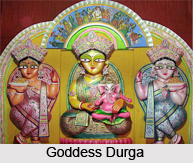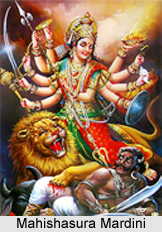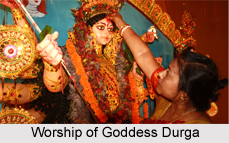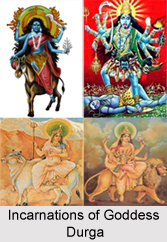 Goddess Durga is an incarnation of Devi, the mother of the universe and is supposed to be the force behind the creation, preservation and destruction of the world. Durga, which means invincible in Sanskrit, is portrayed as having 10 arms, riding on a tiger or a lion. She holds various weapons in her hands including the chakra from Lord Vishnu and a trident from Lord Shiva, along with a lotus flower. Goddess Durga appears in a state of practicing Mudras or hand gestures, adorned with a meditative smile on her face. She is believed to be an embodiment of Shakti and exists in a state of Svatantrya or self-sufficiency. The Hindu Goddess Durga was manifested when the gods were threatened by the demonic and evil forces of Mahishasura. All the gods united their divine radiance and created her in order to vanquish the demons, led by Mahishasura.
Goddess Durga is an incarnation of Devi, the mother of the universe and is supposed to be the force behind the creation, preservation and destruction of the world. Durga, which means invincible in Sanskrit, is portrayed as having 10 arms, riding on a tiger or a lion. She holds various weapons in her hands including the chakra from Lord Vishnu and a trident from Lord Shiva, along with a lotus flower. Goddess Durga appears in a state of practicing Mudras or hand gestures, adorned with a meditative smile on her face. She is believed to be an embodiment of Shakti and exists in a state of Svatantrya or self-sufficiency. The Hindu Goddess Durga was manifested when the gods were threatened by the demonic and evil forces of Mahishasura. All the gods united their divine radiance and created her in order to vanquish the demons, led by Mahishasura.
Goddess Durga, the Supreme Being, has been described in various manuscripts like Taittareya Brahman, Taitriya-aranyaka, Vajasaneyi Samhita and Yajur Veda. Moreover, Durga`s origins and activities are discussed further in Devi Mahatmyam. Durga is another aspect of Parvati, the wife of Lord Shiva. Goddess Kali is considered as one of her incarnations. She is portrayed to be the mother of Ganesha, Kartikeya, Lakshmi and Saraswati during the Durga Puja festival, also known as Navaratri, celebrated in the month of Ashvin.
Origin of Goddess Durga
According to the Devi Mahatmyam, Goddess Durga was formed as a warrior goddess to fight Asura Mahisha. The demon had terrorised the earth, heaven and hell and the gods failed to defeat him as Lord Brahma had bestowed him with the boon of not being defeated by a man. The gods led by Brahma approached Vishnu and Shiva for help. The holy Trinity then united their divine radiance and Goddess Durga appeared out this band of light. She had emerged to annihilate Mahishasura and save all the divine beings. She received her weapons from various gods, like Shiva`s Trishul, Vishnu`s Chakra, Brahma`s kamandalu, Indra`s thunderbolt, Kuber`s Ratnahar etc.
The demonic Mahishasura put up a rampaging fight against her changing forms in a battle between them But eventually, he was paralysed by the intense and radiant light that emitted from Durga`s body. She then resonated with laughter and defeated the Asura with her sword by beheading him. Thus, she is also known as Mahishasurmardini - the slayer of Mahisasura.
 Worship of mother goddess in her various aspects embark on in autumn, which marks the inauguration of the harvest season in Bengal. In the autumnal worship of Durga, her first representative is a branch of the bilva tree. In the second stage the representative is the Navapatrika - female figure made with plantain trees, other plants and herbs. Also mother is often identified in her worship with rice (dhanyarupa). An epithet of Durga is Shakamvari, i.e. herb nourishing goddess.
Worship of mother goddess in her various aspects embark on in autumn, which marks the inauguration of the harvest season in Bengal. In the autumnal worship of Durga, her first representative is a branch of the bilva tree. In the second stage the representative is the Navapatrika - female figure made with plantain trees, other plants and herbs. Also mother is often identified in her worship with rice (dhanyarupa). An epithet of Durga is Shakamvari, i.e. herb nourishing goddess.
Legends of Goddess Durga
Goddess Durga is regarded as an incarnation of Devi has several forms. The goddess is associated with several legends such as the Legend of Parvati and Lord Shiva, the Legend of Ravana,Shiva and Parvati, the Legend of Lord Rama and Durga and the Legend of Parvati Inciting Vishnu.
Incarnations of Goddess Durga
There are several incarnations and embodiments of Goddess Durga, like Gauri, Bhavani, Lalita, Kandalini, Rajeswari, Java etc. Other than these, she also has 9 other designations also known as Nava Durga, Brahmacharini, Shailaputri, Chandraghanta, Kalaratri, Skandamata, Siddhidatri, Mahagauri, Kusumanda and Katyayani. The other incarnations of Durga include Parvati, Karunamayi, Ambika and Kali.
Features and Symbolism of Goddess Durga
Usually, Goddess Durga is portrayed wearing red coloured clothes (saree) where the colour red signifies action and protection from evil. She is represented having 10 or 8 arms, carrying many objects, which symbolises the 10 directions or 8 quadrants in Hindu religion, which also signifies that she protects the devotees from all directions. Durga is also depicted as having 3 eyes and thus, she is also called Triyambake which means the 3 eyed Goddess. The right eye signifies action, symbolised by the Sun, the left eye signifies desire, represented by the Moon; and the central eye signifies knowledge, symbolised by Fire.
Capitalist patriarchy has been the simultaneous privatisation and institutionalisation of motherhood loving nurturing mothers and healthy babies. With the emergence of Bengalis as distinctive identity in the Gangetic delta, a confirmation of the spirit of tender motherhood was found in the natural setting which Bankimchandra Chattopadhyay had described so movingly as well watered and fertile (sujalan suphalang,shasyashyamalang). The natural bounty of the soil encouraged the representation of Bengal as an affectionate mother, ever ready to respond to the demands of her children. Apart from religious innuendos, goddess Durga maps her mavericks amidst the feeling of nationalism and the pillars of economy. She is the all pervading, omnipotent, omniscient, omnipresent deity.
 The lion or the tiger is generally seen as Durga`s vehicle. The lion depicts power, determination and will. Goddess Durga riding the lion symbolises her expertise on these qualities. Durga is seen on the lion in the abhay mudra position, which signifies certification of freedom from fear. The sum total of all cells in an organism is one person, so each cell is like one cell and the sum of them is god and beyond that is absolute.
The lion or the tiger is generally seen as Durga`s vehicle. The lion depicts power, determination and will. Goddess Durga riding the lion symbolises her expertise on these qualities. Durga is seen on the lion in the abhay mudra position, which signifies certification of freedom from fear. The sum total of all cells in an organism is one person, so each cell is like one cell and the sum of them is god and beyond that is absolute.
Weapons of Goddess Durga
Goddess Durga occupies many weapons, offered by several gods. The conch shell in her hand represents the scared Om or the Pranava; the thunderbolt represents firmness; the bow and arrows signifies energy; the Sudarshan Chakra which rotates on the finger depicts that the whole world is compliant to her and is at her command; the sword held by Goddess Durga represents knowledge that is not bound by doubts; the Trishul or trident symbolises 3 distinct qualities, Rajas (activity), Satwa (inactivity) and Tamas (non-activity). She is also the eradicator of 3 forms of miseries, namely, mental, physical and spiritual. The lotus, which is not fully bloomed, held by Goddess Durga signifies assurance of success, but not finality.
Worship of Goddess Durga
Goddess Durga is worshipped ardently through out the entire country. Durga Puja is the major annual festival in West Bengal, Orissa, Assam, Jharkhand and Bihar. Durga`s victory over Mahishasura is celebrated as Dussehra, also known as Vijayadashami in Bengali. Dussehra is also celebrated as Rama`s victory against Ravana in North India. Goddess Durga is venerated as Shaarika in Kashmir. During Navaratri devout Shakti worshippers meditate upon the 9 aspects of the goddess, known as Nava Durga. Dussera Navaratri is also celebrated in South India, particularly in Andhra Pradesh. Goddess Durga is revered as Chamundeshwari in Mysore.
Navaratri is celebrated all through out Gujarat and the Garba is conducted on the last day to commemorate the victory of Mahishasurmardhini. In Goa, Goddess Durga is venerated in the peaceful incarnation of Maha Gauri. Shree Shantadurga or Santeri is the patron Goddess of Goa. The forms of Ambabai and Tulja Bhavani are worshipped in Maharashtra.
 Generally, Mother is worshipped in India in her two aspects of Annapurna and Lalita-Mahatripurasundari. Shri Shankara composed a devout hymn praising the power, beauty and glory of the Divine Mother as Annapurna, the "Giver of Food." `Food" is Mother`s boon to worldly persons and sadhakas or spiritual aspirants alike. She is Avidya Maya to worldly persons and Vidya-Maya to the sadhakas. Shankara says, "O Mother Annapurna, O Great Goddess, Presiding Deity of Kasi, O Receptacle of Mercy, grant me alms . . . that I may be firmly established in knowledge and dispassion."
Generally, Mother is worshipped in India in her two aspects of Annapurna and Lalita-Mahatripurasundari. Shri Shankara composed a devout hymn praising the power, beauty and glory of the Divine Mother as Annapurna, the "Giver of Food." `Food" is Mother`s boon to worldly persons and sadhakas or spiritual aspirants alike. She is Avidya Maya to worldly persons and Vidya-Maya to the sadhakas. Shankara says, "O Mother Annapurna, O Great Goddess, Presiding Deity of Kasi, O Receptacle of Mercy, grant me alms . . . that I may be firmly established in knowledge and dispassion."
Durga Temples in India
The most notable temples of Goddess Durga in India are Ambabai Temple in Kolhapur, Maharashtra; Durgamba Temple in Uttar Kannada District, Karnataka; Maa Bamleshwari temple in Dongargarh, Chhattisgarh, Kalighat Temple in Kolkata; Kulanjari Mata Temple in Aligarh, Uttar Pradesh; Kanaka Durga Temple, Vijayawada, Andhra Pradesh; Shitla Mata temple in Patna, Bihar; Shanta Durga temple in Goa; Ambika Mata Temple near Mount Abu, Rajasthan; Tulja Bhavani Temple in Tuljapur, Maharashtra; Biraja Temple in Jajpur, Orissa and many others.









